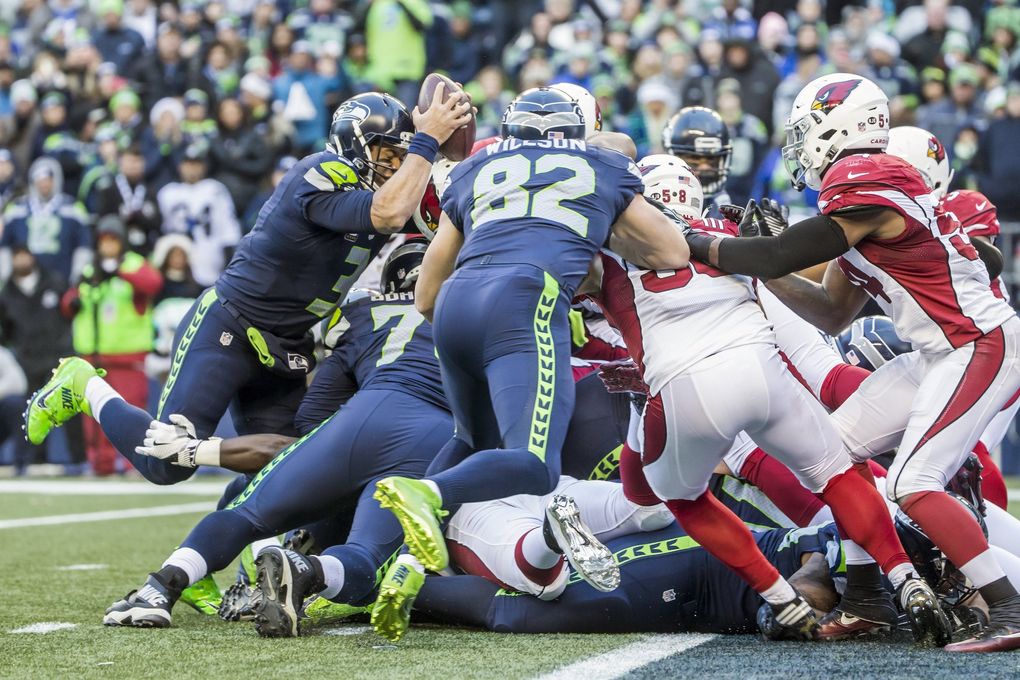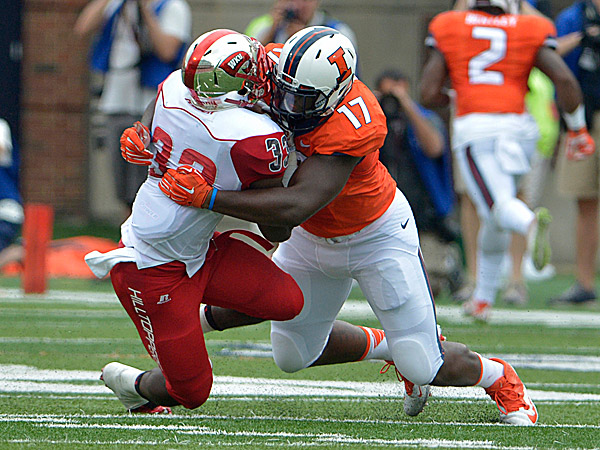
Oklahoma’s Kyler Murray is the best draft eligible quarterback
I’m going to keep updating the tier list. It’ll change if players decide not to declare. It’ll change if I study a player and decide they need to be included. That happened this week with a pair of Oklahoma prospects.
Tier 1 — the top of the class
Nick Bosa (DE, Ohio State)
There’s still no challenge to Bosa for #1 overall and he deserves a tier to himself. He’s the complete defensive end — with the quickness and rare agility to be a dominant speed rusher, the power to manhandle offensive linemen and the size/toughness to work against the run. In a year without a top quarterback prospect or offensive tackle, Bosa goes #1.
Tier 2 — likely top-10 picks
Quinnen Williams (DT, Alabama)
Clelin Ferrell (DE, Clemson)
Ed Oliver (DT, Houston)
Rashan Gary (DE, Michigan)
Dexter Lawrence (DT, Clemson)
Christian Wilkins (DT, Clemson)
Raekwon Davis (DT, Alabama)
Quinnen Williams has been a dominant force for Alabama but there will be some mild concerns about his age (19) and the fact he’s a one-year wonder. Clelin Ferrell has ideal size and length and would be a top-five pick in any class. Ed Oliver is extremely dynamic but there will be some questions asked about his fit at the next level due to his lack of length and size. Rashan Gary and Dexter Lawrence wowed High School recruiters and were the #1 and #2 top prospects in the country. One scout for Rivals called them the best defensive tackle duo he’d ever seen in one single class. They’ve long been destined for the pro’s and NFL scouts will love this pair. They will go early. Christian Wilkins is a phenomenal player with fantastic athleticism, prototype three-tech size, excellent character and technique. Ignore the critics. Raekwon Davis is a monster built like Calais Campbell.
Tier 3 — possible top-15 picks
Devin White (LB, LSU)
Jachai Polite (EDGE, Florida)
Derrick Brown (DT, Auburn)
Kyler Murray (QB, Oklahoma)
I’ve added Kyler Murray to this tier. As I noted on Wednesday, I think he’s the best eligible quarterback prospect and a possible first round pick. At least one NFL GM agrees. He’s accurate, exceptionally athletic and simply a fantastic playmaker. If I needed a quarterback in this draft, I’m going to take Murray and roll the dice. Devin White was once considered the next Leonard Fournette. He was projected as a running back in High School, then he added a lot of bulk and lost some speed. Recruiters started to project him to full back, believe it or not. Then he slimmed down at LSU and became an elite college linebacker. Jachai Polite’s motor never stops. His effort is incredible. He lacks length and size but he’s extremely quick and aggressive as a pass rusher and has been productive despite facing a number of double teams in 2018. Derrick Brown is a complete defensive tackle. He controls the LOS, shows excellent discipline in the run game and makes an impact as a pass rusher too.
Tier 4 — possible top-20 picks
Zach Allen (DE, Boston College)
Josh Allen (EDGE, Kentucky)
David Edwards (T, Wisconsin)
Zach Allen has been a force all season. He’s big and looks like an interior rusher but still wins with get-off, speed and his hand use and technique is on-point. The combine will be big for him but he has a legitimate chance to secure a place in the top-20. Josh Allen has been a consistently effective pass rusher all season. He’s probably best suited to playing as a pure 3-4 OLB in a scheme like Pittsburgh’s. Georgia had success running right at him and Vanderbilt’s tight end also handled him. Even so, he gets to the QB and makes plays. David Edwards is a pure right tackle but teams will like his attitude, consistency and toughness.
Tier 5 — Top-40 talent
D’Andre Walker (LB, Georgia)
Byron Murphy (CB, Washington)
Jerry Tillery (DT, Notre Dame)
Damien Harris (RB, Alabama)
Brian Burns (EDGE, Florida State)
Rodney Anderson (RB, Oklahoma)
We’ve been saying all season that D’Andre Walker is underrated and it took a big performance against Alabama to finally gain some recognition. Walker is very strong against the run despite his linebacker size. He’s capable of rushing the passer as a defensive end, dropping into space and he always plays with a high intensity. Byron Murphy flies to the ball-carrier and looks like a naturally gifted defensive back. He plays cornerback for Washington but I’d love to see him tried at free safety. Jerry Tillery was recruited as a left tackle before switching to defense. He’s as big as Raekwon Davis and provides an alternative later in the top-40. Damien Harris is highly explosive and the complete running back. Brian Burns had a terrific year and could be listed higher but there are legitimate concerns about his weight (is he really playing in the 220’s?). Rodney Anderson will not go early due to injury concerns but in terms of pure talent — he’s right up there. Explosive, great size, tough. An excellent prospect who just needs to stay healthy.
Tier 6 — best of the rest
Marquise Brown (WR, Oklahoma)
Kaden Smith (TE, Stanford)
Drew Lock (QB, Missouri)
Chauncey Gardner-Johnson (CB/S, Florida)
Jaylor Ferguson (EDGE, Louisiana Tech)
Austin Bryant (EDGE, Clemson)
Taylor Rapp (S, Washington)
Marquise Brown is sudden and a fantastic playmaker. He was a little inconsistent against Texas in the Big-12 Championship game and then got hurt. He’s Antonio Brown’s cousin. Kaden Smith is the most rounded draft-eligible tight end. Drew Lock could easily be the first quarterback taken and could’ve been a first rounder this year. Chauncey Gardner-Johnson switched to nickel corner from safety in 2018. He’s extremely physical and plays with personality and attitude. He can be boom-or-bust. Jaylon Ferguson had major production in 2018 but plays with raw technique. With a good combine, some teams will believe he’s worth selecting early to develop. Austin Bryant is a pure pass rusher who will make plays in a rotation. Taylor Rapp is athletic with the ability to leave an impression and could be the first safety off the board.
Still intriguing
Gerald Willis II (DT, Miami)
Johnathan Abram (S, Mississippi State)
Christian Miller (LB, Alabama)
Steven Montez (QB, Colorado)
Gerald Willis will need to explain to teams a bizarre college career that started at Florida, appeared to be going way off the tracks and then ended with a fantastic year of production in Miami. He’s undersized and might be a specialist rusher but he plays with supreme agility and will test well in the short shuttle. Johnathan Abram is a playmaking safety but there are concerns about his athletic upside. A big combine performance could push him into the top-40. Christian Miller will test well and has developed into a more complete player in 2018. Steven Montez isn’t expected to declare for the draft but if he changes his mind could still provide an intriguing alternative to the big name quarterbacks.
Overrated players (or players who might go earlier than they should)
Greedy Williams (CB, LSU)
Dre’Mont Jones (DT, Ohio State)
Jonah Williams (G, Alabama)
Greg Little (T, Ole Miss)
Deionte Thompson (S, Alabama)
Deandre Baker (CB, Georgia)
Montez Sweat (EDGE, Mississippi State)
A.J. Brown (WR, Ole Miss)
N’Keal Harry (WR, Arizona State)
J.J. Arcega-Whiteside (WR, Stanford)
D.K. Metcalf (WR, Ole Miss)
Dwayne Haskins (QB, Ohio State)
Greedy Williams will likely be the first cornerback off the board, possibly in the top-15. However, he still needs a lot of work and shares some of the same issues as Deandre Baker when tracking the ball in the air. Williams has the size and looks the part but might underwhelm at the next level. I think he’s overrated and generally projected too early. Dre’Mont Jones looks great at times as an interior pass rusher. He’s quick and fluid and gets into the backfield to make plays. He also disappears from games (an issue stretching back to High School) and is a liability against the run. Jonah Williams plays left tackle at Alabama but is a pure guard, lacking the length and foot-speed to play outside. He’s best blocking head-on 1v1 and has limitations. I wouldn’t consider him a round one prospect, especially at tackle. Greg Little similarly looks a bit stiff handling the edge and might need to kick inside to guard.
Deionte Thompson is a long, lean safety. He isn’t rangy or particularly fast. He might run in the late 4.5’s or 4.6’s. He’s physical but I don’t understand the first round hype. The Seahawks could look at him as a day-three corner convert based on his frame. Deandre Baker lacks size, struggles to track the ball and might not test particularly well at the combine. There are character flags lingering over Montez Sweat according to Tony Pauline and while he’s a capable college pass rusher, he’s very lean and his success might not translate to the next level. A.J. Brown competes for the ball in the air but how athletic is he? Is he just another Laquon Treadwell? N’Keal Harry wins plenty of contested catches and has YAC ability but struggles to separate. J.J. Arcega-Whiteside is merely a useful redzone target and jump-ball specialist. He might be a day-three pick. D.K. Metcalf has a ton of potential. However, he has a serious neck injury. He’s declared to set the wheels in motion for a pro-career, rather than spend 2019 sitting out at Ole Miss. His long-term future is still a question mark. He likely just wants to get into the league. I doubt he’s expecting to be drafted early. Dwayne Haskins has talent and production. There were also too many ‘off’ throws. Personally, I think he’s a mid-rounder with some potential to work with over time.
Players I’m still unsure about
Jeffrey Simmons (DT, Mississppi State)
Daniel Jones (QB, Duke)
Cody Ford (T, Oklahoma)
Devin Bush (LB, Michigan)
Jeffrey Simmons is a good player. He was also filmed beating up a defenceless woman. Many teams won’t have him on their board. I’ve listed him here simply to avoid having to answer questions in the comments section about where he fits. Someone will draft him. I can live without it being the Seahawks. Daniel Jones has shown flashes of quality at Duke and could slip into the 20’s. I need to do more study before confirming that thought. I’ve not studied Cody Ford enough to pass judgement but Tony Pauline believes he could rise into the first frame. Devin Bush is not bad player at all. However, there are some concerns and I don’t see a first round prospect. Bush was asked to be very aggressive by Michigan. He had two key roles — attack the LOS to try and make plays in the backfield and cover passes to the flat. That’s not his fault but it makes for a difficult evaluation. There wasn’t too much in the way of read-and-react, discipline vs the run and zone coverage. In one game I saw him attack the LOS leaving a simple outside cut for the running back to break off a big gain. He needed to be less aggressive and simply force the runner back inside. He has energy and speed but it’s hard to get a sense for how his game translates to the next level watching Michigan play.
You can now support Seahawks Draft Blog via Patreon by clicking the tab below.







